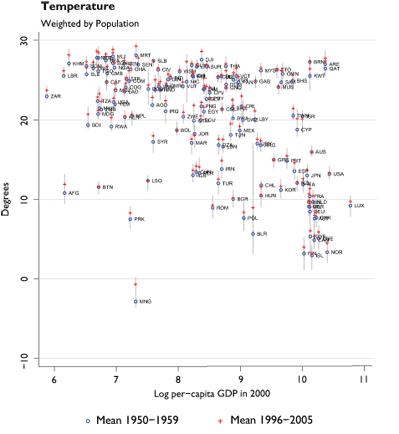Featured Faculty
Gordon and Llura Gund Family Professor of Entrepreneurship; Professor of Strategy; Co-Director of the Ryan Institute on Complexity; Professor of Economics (Courtesy)
Climate change presents poor nations with an unfortunate paradox: Though they missed out on the riches of the fossil fuel era, they appear doomed to suffer the worst of its consequences. Many experts predict climate change will drag down national income, but how and where such effects may be felt has been anyone’s guess until recently. Now research suggests that heat may hinder growth in poor nations while leaving wealthy ones relatively untouched.
High temperatures are sometimes blamed, fairly or not, for the lack of development in many poor nations. But since climate change will almost certainly make them hotter, the issue has taken on new importance. New research by Ben Jones, associate professor of management and strategy at the Kellogg School of Management, Melissa Dell, doctoral student at MIT, and Benjamin Olken, a professor also at MIT, found rising temperatures in the late twentieth century hurt poor countries in myriad, previously unknown ways, affecting everything from income to investment, innovation, and political stability.
But most surprising, according to Jones, was that the warming trend appeared to be “affecting the rate of economic growth as opposed to simply the level of it.” He had expected a slump in output, but not the alarming drop in growth. A period of low output can be a temporary handicap, but reduced growth can cause lasting economic damage. For example, a dry year can devastate harvests, but if the drought lifts the following year, harvests can rebound. These drought-year harvests represent lost output, but a recovery means no lasting damage is done. But if during the drought the farmer’s cattle died for lack of water, her future harvests will suffer, too. She may never see the same yields again. “Once you get an effect on growth, you lose your output one year and you don’t get it back,” Jones says.
Wide-ranging Effects
Agriculture was not the only victim. Jones notes, “We saw effects of temperature changes on industrial output in these countries, effects on aggregate investment levels, effects on political stability—even effects on scientific outputs.”
Rather than attempt to predict the economic effects of future climate change, Jones and his colleagues eschewed notoriously complex forecasting models. Instead they dove into historical records to determine the effect of heat waves in the past. Five decades of climate records detail temperature and precipitation across the entire globe, data the authors further refined into national annual averages. They also collected economic data for 136 countries, tallies of scientific publications, and measures of political stability.
Jones and his colleagues then ground the numbers through a model, distilling the effects of temperature and precipitation on each component. Though historical variation in average precipitation did not play a major role, the variations in temperature had far-reaching effects. Poor countries took the most direct hit—GDP per person dropped by just over 1 percent when the temperature was 1˚ C higher, while agricultural and industrial output both fell almost 2.5 percent. Poor countries also invested less, generated fewer scientific publications (a measure of innovation), and became less stable—their governments were almost twice as likely to be overthrown in warmer years.

Each country’s temperature plotted against log gross domestic product (GDP) per capita. Note the general trend of poor countries at high temperatures (upper left of the plot) with richer countries at lower temperatures (lower right of the plot). Also note the change in average temperature for each country between 1950-1959 (blue) and 1996-2005 (red).
The breadth of these effects is remarkable, but what surprised Jones and his colleagues the most was the unambiguous mark that rising temperatures left on economic growth. Between 1970 and 2000, the one degree of warming reduced annual growth in poor countries by as much as 3.2 percent. Growth in exports—especially agricultural products and consumer goods such as cameras, shoes, and small appliances—also fell off.
Explaining the Drop
Jones offers two possible explanations. First, agriculture dominates the economies of many poor countries, and farming is particularly susceptible to the vagaries of the weather. “It could be that many of the other effects that we see on investment and industrial value-added and even political stability are essentially knock-on effects from the problems in the agricultural sector,” Jones speculates.
The second explanation has to do with human physiology. “There is a lot of laboratory evidence showing that people are less productive both physically and cognitively in high temperatures,” Jones says. Take footwear manufacturing and their infamous sweatshops as an example, Jones says. “The sweatshop might get sweatier in high heat, and people are correspondingly less productive.”
Though poor countries have already suffered ill effects from warming, Jones says the next century could be even more difficult. Temperatures are expected to rise 3˚ C by 2100, making the warming to date seem trivial. Even if poor countries can fully adjust to new, higher temperatures in just ten years—an optimistic assumption—their average growth rate will be 0.6 percent lower by 2100. While 0.6 percent may seem small, growth rate effects accumulate over time so that the median poor country would have 50 percent lower income by the end of the century. At the same time, rich countries may continue to grow at their historical rates, further widening income inequality.
But while rich countries may be able to avoid the direct impact of climate change, they may not be entirely immune, Jones adds. “An increase in inequality may pose problems for the richer countries as well,” he says. Lower productivity in poor countries could raise prices across the globe, and political instability could send out wave after wave of refugees.
“No country, even if they are an island, is truly an island in terms of the global economy,” Jones says.
Dell, Melissa, Benjamin F. Jones, and Benjamin A. Olken. 2012. Temperature Shocks and economic growth: Evidence from the last half century. American Economic Journal: Macroeconomics, July, 4(3): 66-95.